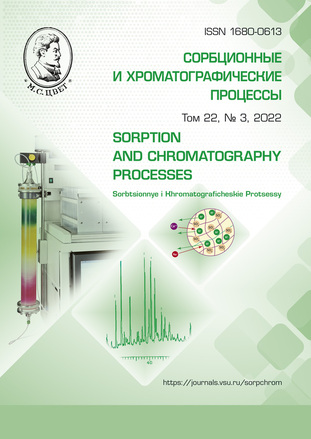Determination of azo dyes in non-alcoholic beverages by TLC
Abstract
The development of techniques for the identification and quantification of azo dyes in food is an important issue in Russia due to the lack of proper external control over the manufacturer. The monitoring function is the responsibility of the food manufacturer. Therefore, the easiest dye control methods such as thin layer chromatography (TLC) are preferable for use at the production site. Producers of non-alcoholic beverages often use mixtures of colourants, so it is necessary to separate them before spectrophotometric determination. In analytical chemistry, the methods of sample preparation include thin-layer or paper chromatography, as well as solid-phase extraction (SPE). The aim of this study was to determine azo dyes in non-alcoholic beverages by TLC using computer densitometry.
The combination of TLC and densitometry makes it possible to measure the colour intensity of the dye spot directly on the chromatogram. The TLC Manager software, which is similar to the double beam densitometer, allows the processing of graphic files in jpeg format. We used TLC with computer densitometry to determine the concentration of azo dyes after their extraction from non-alcoholic beverages on aluminium oxide at pH=2.
We determined that the extraction of azo dyes with aluminium oxide at pH 2 made it possible to selectively extract them from aqueous solutions, and the sorption efficiency was >92%. The sorption process takes place mainly through electrostatic interaction between Bronsted cationic centres of aluminium oxide and the anionic forms of the azo dyes, which has been confirmed by infrared spectroscopy.
This method was validated when determining azo dyes in non-alcoholic beverages Lubimy, Dobry, Fritty Light Tropic, and Frutmotiv. In these beverages, we detected tartrazine E102, Sunset Yellow E110, and azorubine E122, not declared in the composition of the beverages. The content of azo dyes in some beverages exceeded the maximum permissible level. TLC with SPE and computerised densitometry can detect azo dyes with high selectivity and sensitivity. Therefore, this technique can be used in the quality control of non-alcoholic beverages.
Downloads
References
SHaulina L.P., Korsun L.N. Kontrol' kachestva i bezopasnosti pishchevyh produktov i prodovol'stvennogo syr'ya: ucheb. posobie. Irkutsk. IGU. 2011. 111 p. (In Russ.)
Mayurnikova L.A., Kurakin M.S. Pishchevye i biologicheski aktivnye dobavki: uchebnoe posobie. Kemerovo. KTIPSHCH. 2006. 124 p. (In Russ.)
Donchenko L.V., Nadykta V.D. Bezopasnost' pishchevogo syr'ya i produktov pitaniya. Moskva, Pishchevaya promyshlennost'. 1999. 352 p. (In Russ.)
Hal'zova S.A., Zyablov A.N., Selemenev V.F. Opredelenie sinteticheskih krasitelej metodom TSKH. Sorptsionnye I khromatograficheskie protsessy. 2014; 14(3): 544-547. (In Russ.)
Pishchevye dobavki i kontaminanty / Vsemirnaya organizaciya zdravoohraneniya, Prodovol'stvennaya i sel'skohozyajstvenna-ya organizaciya OON. M. Ves' mir. 2007. 495 p. (In Russ.)
Sanitarnye pravila i normy: gigienicheskie trebovaniya po primeneniyu pishchevyh dobavok: [normativnoe izd.]. M. Omega-L. 2007. 274 p. (In Russ.)
GOST R 54491-2011. Konservy fruktovye. Metod opredeleniya nalichiya hinolinovyh, triarilmetanovyh i azo-krasitelej. M. 2012. 12 p. (Standart-inform). (In Russ.)
Khal'zova S.A. Diss. kand. him. nauk. Voronezh. 2017. 157 p. (In Russ.)
Khal'zova S.A., Zyablov A.N. Iden-tifikaciya sinteticheskih krasitelej E102, E110, E124 v bezalkogol'nyh napitkah metodom TSKH s primeneniem komp'yuternoj densitometrii, ʻʻTheory and practice of chromatographyʼʼ, abstracts of reports of the All-Russian conference with international participation dedicated to the memory of Professor M.S. Vigdergauz, May 24-30. 2015. Samara. 2015. P. 114.
Saprykin L.V., Saprykina L.V., Metodologiya analiticheskogo primeneniya tverdofaznoj ekstrakcii. Sorptsionnye I khromatograficheskie protsessy. 2007; 7(3): 379-409. (In Russ.)
WEB stranica Plahotnogo I.N. Available at: http://www.garryc2008.narod.ru (accessed 14 February 2014). (In Russ.)
Al'bert A., Serzhent E. Konstanty ionizacii kislot i osnovanij: per. s angl.; pod red. B.A. Poraj-Koshica. M. Himiya. 1964. 180 p. (In Russ.)
Marchese L., Bordiga S., Coluccia S., Structure of the surface sites of – Al2O3 as determined by high-Рesolution transmis-sion electron microscopy, computer modeling and infrared spectroscopy of adsorbed CO. J. of the Chemical Society, Faraday Transactions. 1993; 89: 3483-3491. https://doi.org/10.1039/FT9938903483
CHukin G.D. Stroenie oksida al-yuminiya i katalizatorov gidroobesseri-vaniya. Mekhanizmy reakcij. M. Paladin. OOO «Printa». 2010. 288 p. (In Russ.)
Lisichkina G.V. Himiya privityh poverhnostnyh soedinenij. M. FIZMATLIT. 2003. 592 p. (In Russ.)
Morozova G.N. Identifikaciya sinteticheskih pishchevyh krasitelej metodom TSKH. J. Nutrition issues. 1977; 1: 85-87. (In Russ.)
Malahova I.I., Krasikov V.D., Pacovskij A.P., Kulev D.H. Patent RF. no 2177150. 2000. (In Russ.)







